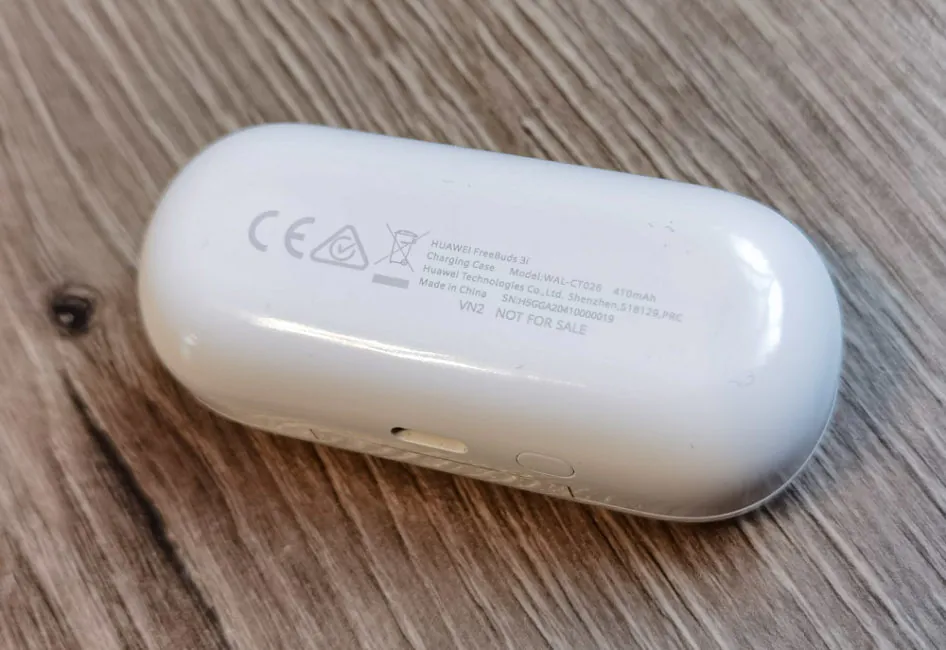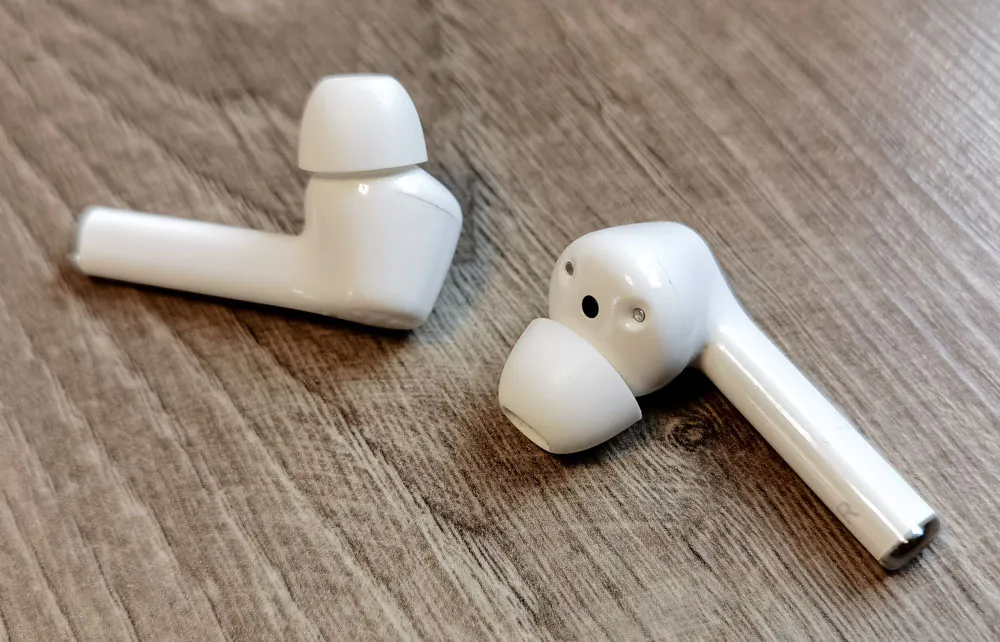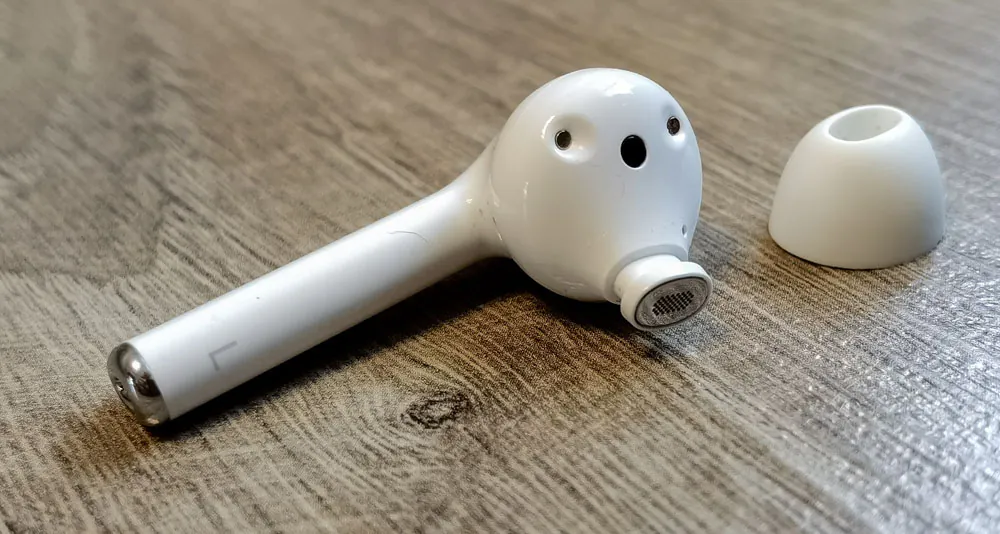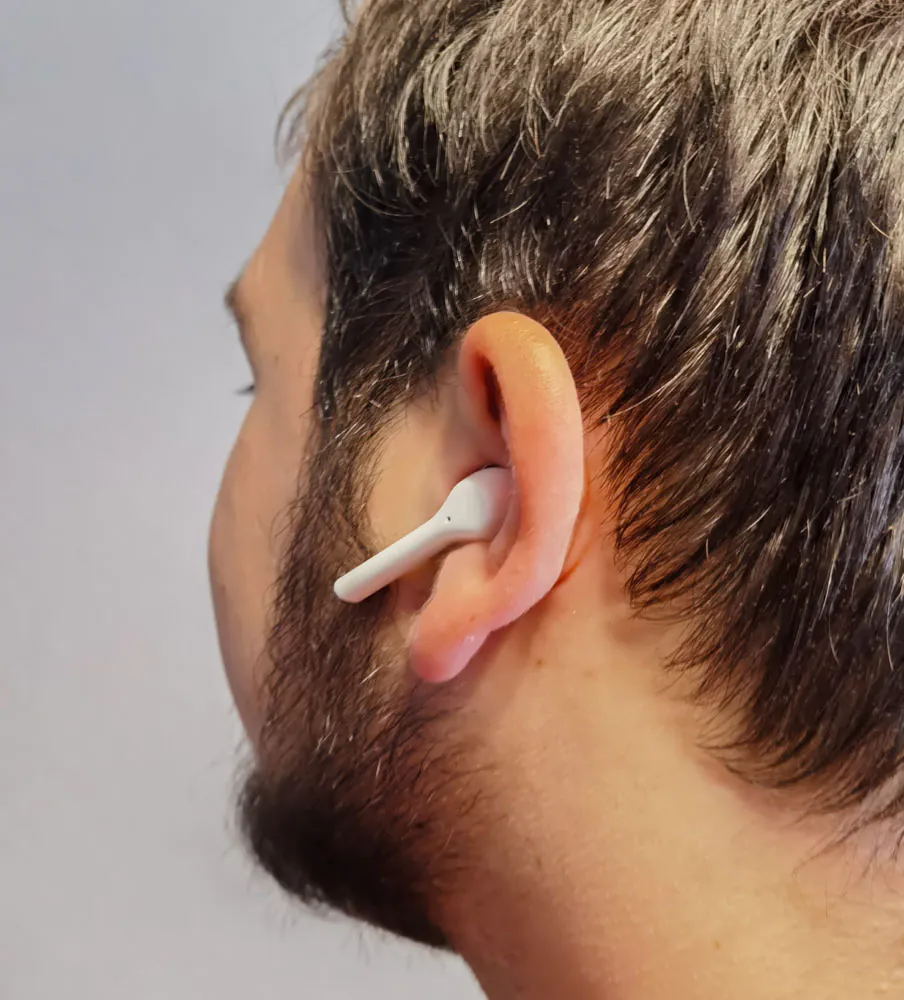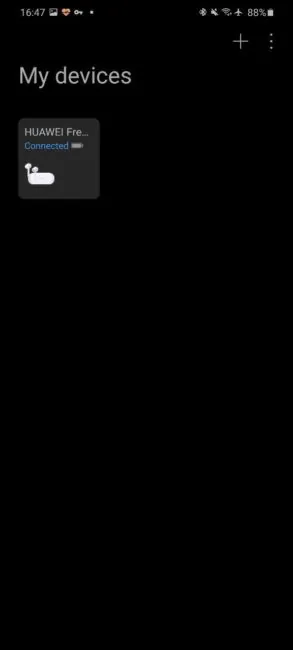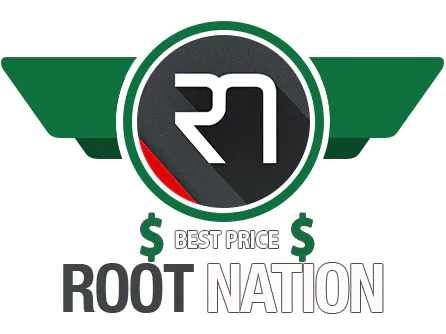© ROOT-NATION.com - Use of content is permitted with a backlink.
Huawei FreeBuds 3i is a new TWS-headset which is positioned as a simplified model of the current line, where FreeBuds 3 is the flagship. In this review we will figure out what are the differences between the two models. I will not particularly lean on the characteristics – you can check them anywhere. I will share my experience, impressions and test results, as well as compare it with the closest competitors.
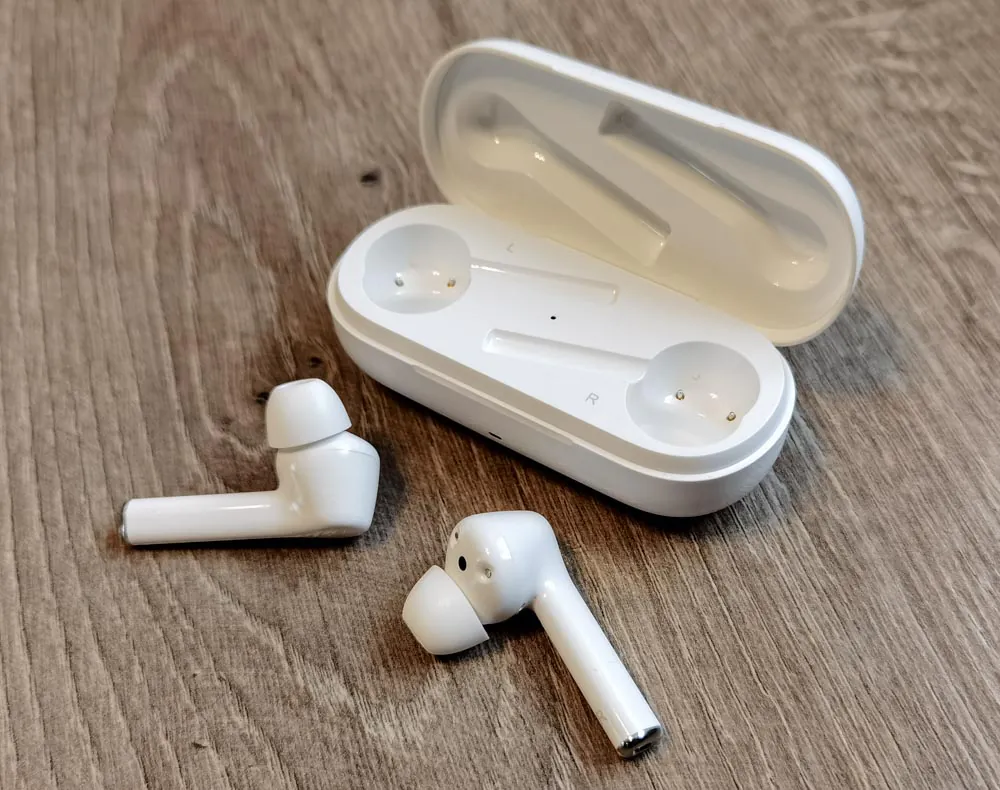
Positioning and price
The first difference is the much lower price. Indeed, the official recommended price of Huawei FreeBuds 3i is about $111. Huawei FreeBuds 3 sells for approximately $185. The difference is significant.
The main competitor of 3i is Samsung Galaxy Buds+ (the official price is $148), which, fortunately, I have on hand, so I will also compare these two models. At the same time, last year’s Galaxy Buds now costs just exactly the same as 3i. But direct competition in this case does not quite go in favor of the Samsung headset, because it does not have important innovations of the current model.

The main thing worth noting is that FreeBuds 3i is probably the cheapest headset with ANC (Active noise control) from the A-brand. So you understand why I don’t mention Apple AirPods Pro. It’s just that the price there is generally beyond my understanding, despite the fact that it has fewer features.
Where to buy:
- AliExpress
- ebay
What’s in the box
A simple thick cardboard box framed in white and gold. In front is a product image. At the back is basic information in various languages. Inside we see a charging case. Headphones are located inside. We raise the top layer of the package and see the first box with documentation and the second with a charging cable and three pairs of interchangeable tips of different sizes. A fourth pair of medium-sized tips is mounted on the headset.
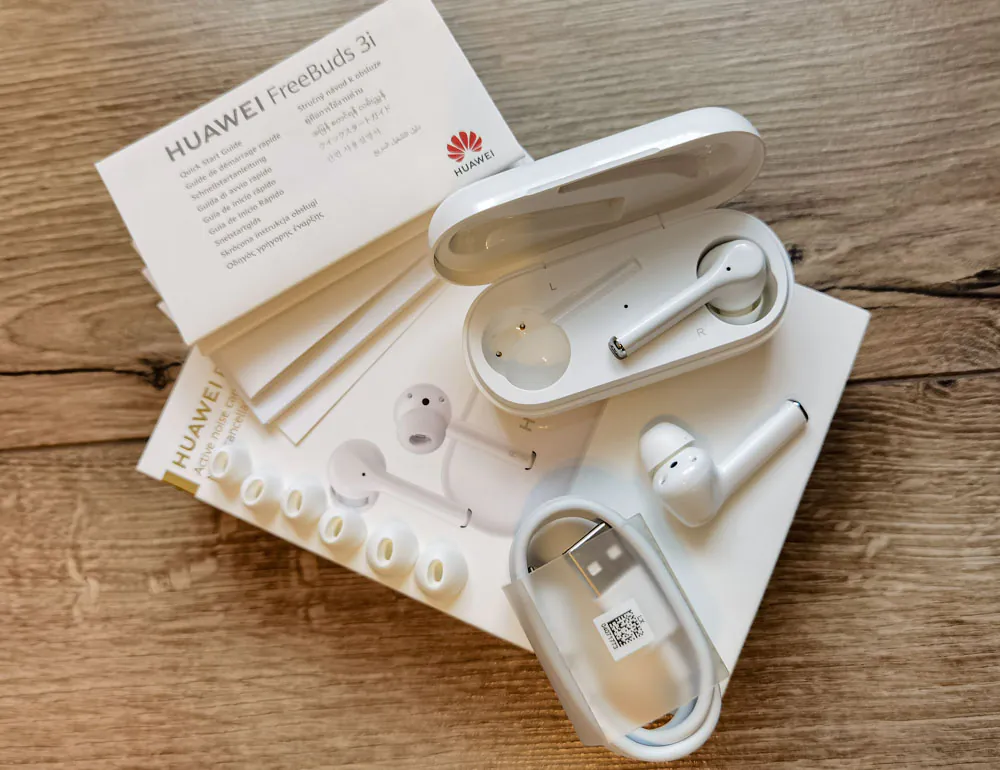
Design, materials, build quality
As for design and construction, Huawei FreeBuds 3i is not at all similar to FreeBuds 3, but it resembles the older models like FreeBuds and FreeBuds Lite.
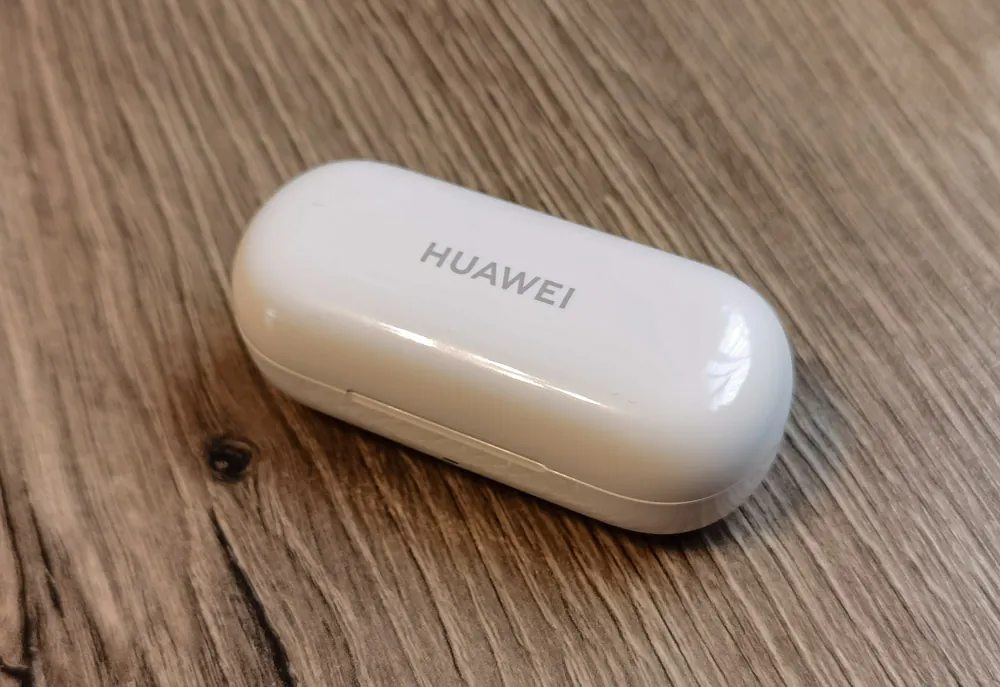
The charging case is the same oblong box in the form of a rounded pill with flat upper and lower faces.
Headphones are also similar to these models: a body with a speaker and a leg in the style of AirPods. But the shape of the case has changed a bit. Previously, it was teardrop-shaped, but now it looks like a truncated cone with a touch button.

The material of all elements of the headset is plastic. Mostly glossy – the outer part of the case and the headphones themselves. Inside, the case is matte with glossy niches for headphones. And only the ends of the legs of the headphones are shiny silver. The earphones are protected against moisture (IPX4).

My model of the headset is white. There’s also a black one.
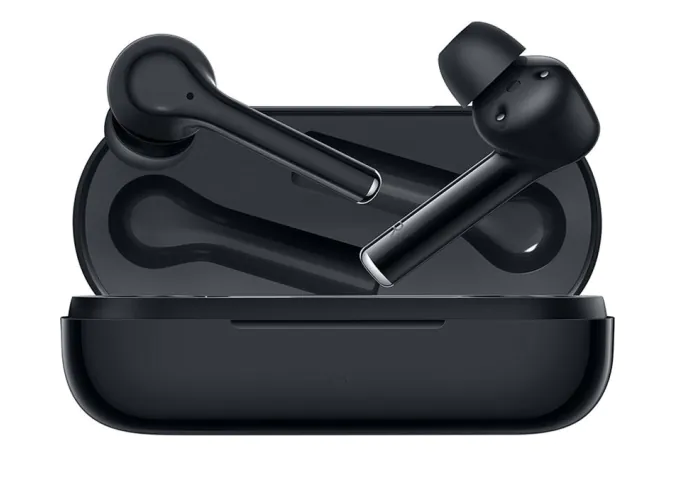
I have to issues with the build quality or the materials used. The quality of the plastic is excellent, it feels strong and thick (2 mm). Everything is neat, nothing creaks. The cover of the case also fits perfectly in both closed and open positions. It’s Huawei, so the quality is good as usual.
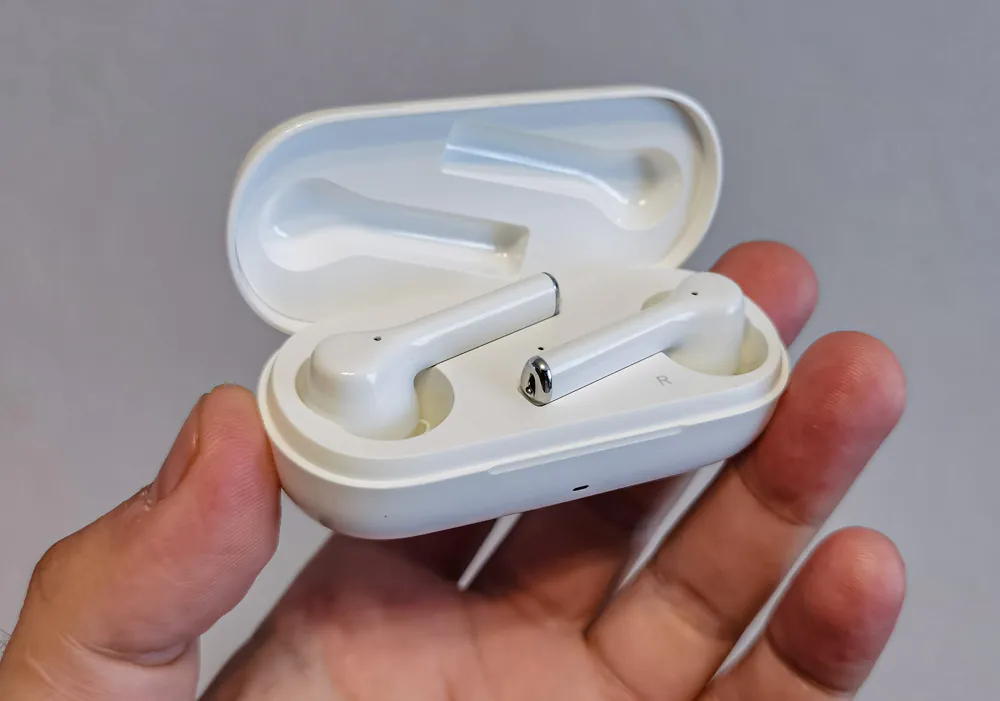
Elements’ configuration
If you are familiar with Huawei’s in-ear TWS headsets of past generations, then you will not find anything unusual here. On top of the case is the manufacturer’s logo. Below is service information. In front is an LED indicator that shows three levels of the current charge of the case – it glows red, yellow and green, respectively. At the back is a USB-C port for charging and a reset button.
Inside the case we see the recesses in the base and cover. The headphones are fixed in place by magnets. There are also 2 pairs of contacts for recharging the headphones in the case.

As I already said, each earphone consists of a body with a speaker and all the electronics and a “leg”. Outside, there is a touch pad with a hole for the first microphone (for noise reduction) at the bottom. On the left you might notice the second main microphone. On the inside of the leg there are R and L markings. On the inside there are two contacts, a proximity sensor window, and an oval fitting with a metal mesh at the end. Near there is another miniature nano-hole, I suspect under the third internal microphone. Why three microphones and why they are important, I will tell you later.
Ergonomics and usability of Huawei FreeBuds 3i
Frankly, I prefer TWS-headsets without legs (like Galaxy Buds). But it is worth noting that these sticks have a reason to exist. On the one hand, you can’t lie on your side since they get in the way. It’s also easier to accidentally hit the headphone when there are lots of people around. On the other hand, it’s easy to grasp the headphone without touching the button. Although, in Huawei FreeBuds 3i, a single touch is not assigned to any of the actions at all, but this is another nuance. In general, with a leg it is more convenient to insert headphones into the ear and remove them from there.

In addition, the legs help to fix headphones in the ears. The size of the earbuds is excellent and they fit well in the auricle. The ergonomics are fine.
I also want to note the good quality of the silicone tips. Finally! I was very unhappy with FreeBuds and FreeBuds Lite. This time, the tips are great – tight but soft. And they are not round, as usual, but oval. And therefore, they are better suited to the shape of the ear canal – they fit well, do not press and the sealing is just excellent. Of course, in addition to pure convenience, the quality of the tips affected the sound, but more on that later.
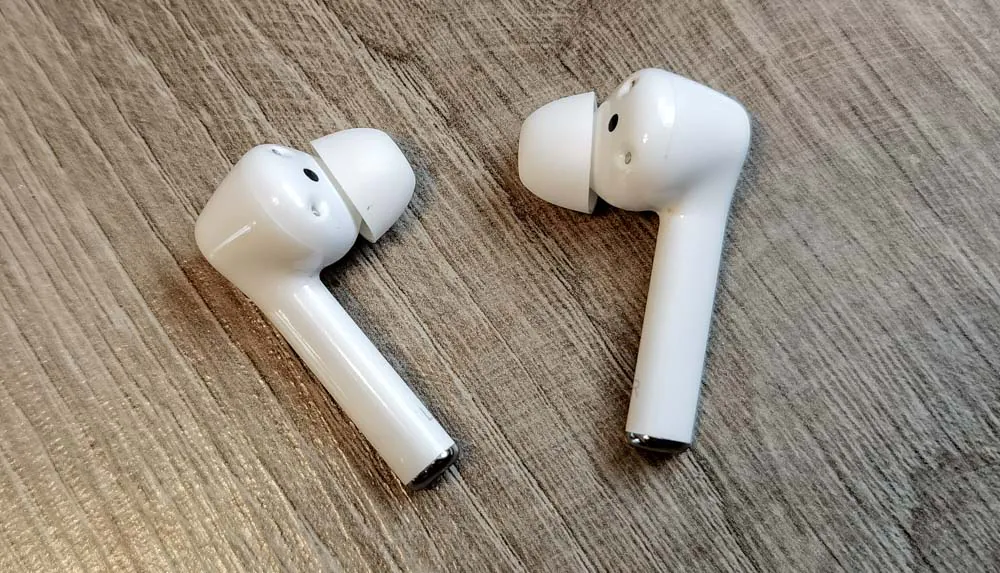
Read also: How to Choose the Best Eartips for Vacuum Headphones – And Why It’s Important
Connection and control
Connecting a headset to a smartphone can be done in 2 or even three ways. And yes, it’s kinda confusing, and soon you will understand why. The fact is that the functionality of the headphones depends on the software that you use on the main device.
The first option is native – if you have a Huawei smartphone on EMUI 10. In this case, when you open the case cover, you will receive a notification on the screen similar to how iOS works when connecting AirPods. Just confirm the connection and that’s all. Neat!
If you later go to the settings through the list of Bluetooth devices by clicking on the gear next to the name of the headset, you can see the control panel of some functions, for example, changing actions by double-tapping the left and right earphones, as well as holding the button. But the second action changes immediately for both headphones and you can only activate the noise cancelling or disable this feature.
The second option is classic. Suitable if you have a third-party smartphone or Huawei with an older version of EMUI. Just go to the Bluetooth settings, find FreeBuds 3i and connect as usual.
Read also: EMUI 10 review – What’s new in Huawei’s version of Android 10
But in this case, you will not get the headphone settings and the ability to update the firmware. Therefore, it is best to install the special Huawei AI Life utility to access all the features.
If you open the application and click on the connected headset, then here you’ll find options at first glance similar to those that we already observed in the settings of EMUI 10. It just looks a little different. BUT! It turns out that when using the AI Life utility, you can access another additional function – Awareness – that seems similar to a feature in Galaxy Buds and Buds+. What it does is use a microphone to amplify background sounds to help you hear what is happening around you. It works like a hearing aid when music is not playing.
If you activate the “Noise control” settings of the AI Life application, then with a long hold of the sensor, another action appears. You can sequentially turn on ANC, Awareness, turn off the function and so on. But in the usual EMUI 10 settings, there is no Awareness option at all! That’s not nice.
Do you understand what is happening? I don’t. It turns out that even on a smartphone with EMUI 10 it is recommended to install the AI Life application to get access to absolutely all functions. What is the point then in duplicating settings in the system menu? Figure it out, Huawei, and stop confusing users. Even I couldn’t understand these variations of software and functions. And what about ordinary customers? Just say that everyone needs the application!
The confusion with functions does not end there. In the case of a smartphone with EMUI 10, the proximity sensor provides an automatic pause function. Take the earphone out of your ear, and music playback stops. Insert it back, and it resumes. But when working with other smartphones, autopause either does not work at all or works halfway. For example, in the case of Galaxy S20+, playback stops automatically, but does not resume, you have to double-click on the sensor.

The main thing that I do not like about Huawei FreeBuds 3i control scheme is the lack of volume control. Or limited functionality overall – you can either switch tracks, or pause, or call an assistant. You won’t get all the functions, because in fact there are only three actions – double-click on the right or left earphone and hold the sensor. And there are much more possible actions. OK, let’s say that you can pause music by simply removing the earphone from your ear (but only with EMUI 10 you can start playback in reverse). But somewhere else, the voice assistant must be attached. So you will have to choose which action is more important to you. But this is nonsense. Even the cheapest Chinese knockoffs are now making headsets with full touch or mechanical controls. Galaxy Buds+ also has everything you might want, although partially thanks to an accelerometer, and not touch buttons, but that’s it’s even cooler. So, yeah, Huawei, you need to do better.
The sound of Huawei FreeBuds 3i
As for the sound, everything is fine. I think FreeBuds 3i is a TWS-headset with the best sound that Huawei has ever created. Yes, the flagship FreeBuds 3 also has good sound, but because of the open format, which doesn’t suit me personally. All the time I try to insert the earbuds deeper into my ears, and then the music has a volume and a wider frequency range. So yes, the sound is good… But gradually the headphones are pushed into some middle position, the sealing is lost and the richness of sound is gone. Perhaps this is a purely anatomical feature of my ears. Headphones do not fall out, but the clarity of low and high frequencies regularly gets lost. And I constantly adjust the eadbuds – again and again. The in-ear headphones lack this issue.

Once again, I want to note the excellent bundled eartips that provide perfect sealing. Which, of course, also directly affects the perception of music in these headphones. This time, Huawei tried not to screw it up, like it did with the previous versions of vacuum headsets, when it was just necessary to select third-party tips in order to get acceptable sound.

Compared directly with the closest competitor, the sound quality of FreeBuds 3i is very similar to Galaxy Buds+, but there are no problems with the bass out of the box this time. In general, low frequencies are deeper and clearer, apparently due to simply huge 10-mm drivers. Frequency range, as well as scene and details, is also good.
Although at first it seemed that FreeBuds 3i high frequencies are a little lacking and the sound is dull. But after 3-4 days of operation, the drivers warmed up, or something, and the sound became quite clear and sharp. This once again proves that you can not rely on first impressions when testing audio equipment, especially if you use completely new copy of the headphones. They must be used for at least a few days.
Active noise control (ANC) and something else
What can I say here, Active noise control really works. It is enough to activate it without playing music and you will feel how the surrounding world gets muted. ANC efficiency is not bad – it eliminates indoor noise without any problems, helps on the street and in transport. And by the way, it does not distort the original sound of the music at all. At least I did not notice it. The implementation is great.

The Awareness function is a godsend. Especially since it wasn’t advertised at all. You can try to find it on the official page of Huawei FreeBuds 3i. I could not. What kind of marketing is this? Hide the feature and not tell potential customers about it? Moreover, this feature competes with the similar option in Samsung Galaxy Buds+. You should not underestimate the usefulness of amplifying external noise when listening to music – it helps to better navigate the busy street and avoid many dangers when moving around the city.
Microphones
Here we come to another highlight of the headset. Let’s consider the quality of Huawei FreeBuds 3i in headset mode for conversations. In addition to traditional noise reduction, when the first microphone perceives your voice, and the second captures the surrounding noises that the electronics are trying to cut off from the conversation, each headphone also has a third microphone that somehow listens to you from the inside.

To understand how this works, try plugging your ears with your fingers and saying something. You will hear your voice through your inner ear right from your head. The headset does the same. An internal microphone captures the vibrations of the vocal cords directly through physical contact with your body. In theory, this improves the voice quality and the overall quality of voice communications. In practice, in combination with traditional noise reduction during conversations, this whole thing works wonderful. None of the people I’ve talked to complained. In most cases, they did not even notice that I was talking through the headset and were very surprised when I told them about it.
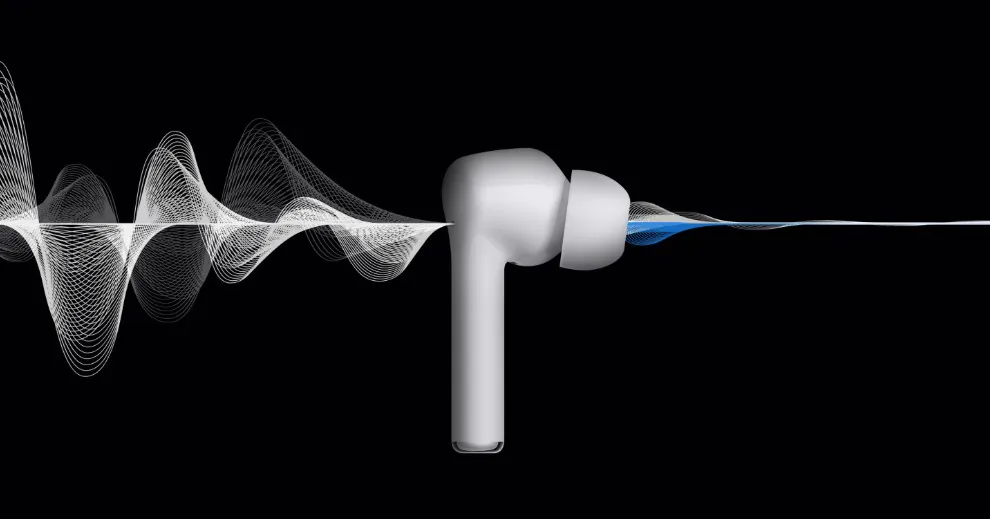
It is worth noting that this feature first appeared in Galaxy Buds+. So in this matter the headsets have approximate parity. And as far as I know, no other headphones use this feature.
Connection Reliability and Delays
Inside you won’t find the proprietary Huawei Kirin A1 chip (unfortunately), as in the flagship model. Therefore, the Bluetooth version here is 5.0, not 5.1. As for the reliability of the connection, the situation is also slightly worse than that of FreeBuds 3, which is logical. But bear in mind that the senior model had phenomenal reliability. In the case of Huawei FreeBuds 3i, rare interruptions do happen. But overall the headset behaves well. Sometimes streaming stutters once an hour. I will say this – Galaxy Buds+ had worse connection. Moreover, the connection is stable even through a reinforced concrete wall. And even through several walls if you do not move fast. And being near a working microwave does not disturb the stream. On the street everything is also pretty decent, even in the most “tough” places, such as shopping malls.
But with a delay, not everything is rosy. I hear it even when watching a video on YouTube. The lag is clearly present, although it is still possible to watch videos. In games, everything is bad, like the most TWS headphones. I can’t recommend this headset to mobile gamers. Perhaps the situation will change for the better after several firmware updates (this happened previously with other Huawei headsets).
Battery life
The capacity of the battery packs is small – only 37 mAh each. The manufacturer promises about 3.5 hours of uninterrupted music on a single charge. In practice, I managed to squeeze 3 hours 17 minutes of playback from the headset at about 50% of the volume without active noise reduction. And 2 hours 50 minutes with ANC on. And the right earphone was the first to disconnect, which means that the ear buds lose power differently. During tests I was using Huawei P40 Pro with AAC codec.

What can I say… It is rather weak in the context of the current market situation. Especially compared to the 11 hours of Galaxy Buds+. And even budget competitors on Qualcomm QCC3020 chips, like Tronsmart Spunky Beat or Onyx Neo, show results in the region of 4-5 hours when using the aptX codec and up to 7 hours on SBC. So for this indicator, Huawei headset is clearly behind the competition.
As for the general autonomy of the headset, taking into account the case (410 mAh), it can reach 14 hours (the cover will recharge the headphones 4-5 times). This is also a rather mediocre result compared to 20-24 hours from competitors.
It takes about an hour to fully charge exhausted headphones in a case, and the case charges for almost 2 hours.
In general, the battery life of Huawei FreeBuds 3i is severely lacking. I have a TWS-headset in my ears almost all day, I listen to music while working, use voice communication, and from this point of view, Galaxy Buds+ does not have real competitors. But if you use headphones periodically, for example, on trips or while jogging and walking, FreeBuds 3i may be enough.
Verdict
Everything is relative. Huawei FreeBuds 3i is a unique product that has no rivals on the market in terms of functions, features and price.
Yes, it doesn’t have a cool chip and doesn’t support wireless charging like the FreeBuds 3. I also see some misses with control, but they are characteristic of all current Huawei TWS headsets. The headset is not perfect, and in terms of battery life it is noticeably inferior to the closest competitor from Samsung and even to many budget models. And this is probably its main disadvantage. But there are lots of positives as well.

After all, do not forget that Galaxy Buds+ cost about $37 more, and this is a very significant difference in price. At the same time, the Huawei headset has a slightly better sound out of the box (and in general the sound is excellent), the connection quality is more reliable, and there is also active noise control, which the competitor simply does not have. In addition, there are other advanced features like the Awareness feature and internal microphones for better voice transmission. And you will not find such capabilities even in AirPoids or Sony headsets that cost much more.
If all of these advantages are important to you, and the disadvantages are not critical, then I see no reason not to recommend FreeBuds 3i. This is a great mid-range TWS headset model with flagship features.
Where to buy
- AliExpress
- ebay
Subscribe to our accounts:



